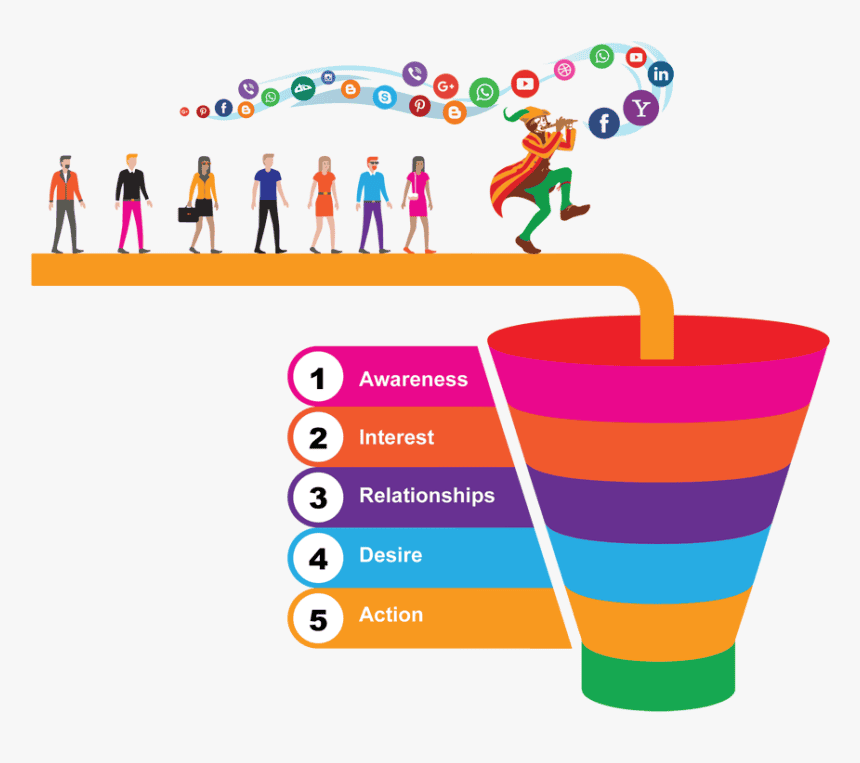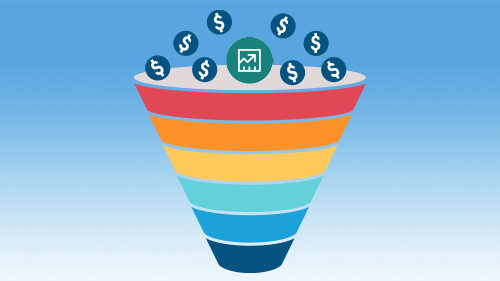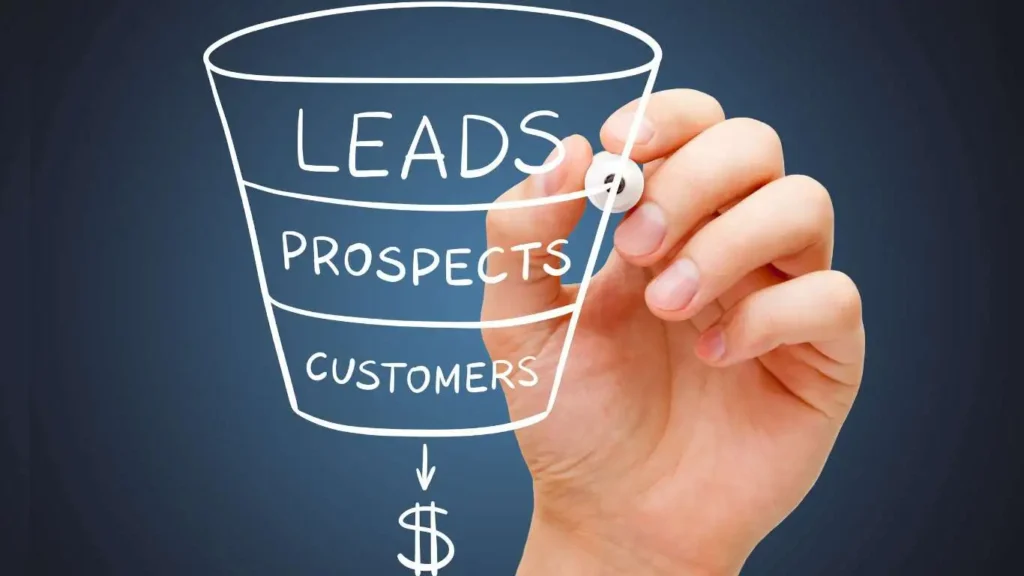Hey man! So, now the magic of the sales funnel comes in. It’s like having a roadmap guiding your potential customers from “Hmm, that’s interesting” to “Shut up and take my money!”. Let’s break down the basics of sales funnels so you can start reeling in those customers like a pro. One of the best ways to optimize your sales funnel is by utilizing tools that streamline the process. For instance, there are several WordPress funnel plugins for sales that can enhance your funnel’s effectiveness, making it easier to capture leads and boost conversions. By implementing these plugins, you’ll be well on your way to turning those leads into loyal customers.
What is a Sales Funnel? The Secret Sauce to Sales Success
Think of a sales funnel as a journey your potential buyer takes. It starts wide at the top with a large pool of people who might be interested in what you offer. As they move through the funnel, they learn more, become more engaged, and eventually, a portion of them convert into paying customers.
Why is this important? Well, it’s all about understanding your customer. By breaking down the sales process into stages, you can tailor your messaging and offerings to meet their needs at every step, making the journey smooth and enjoyable for them (and profitable for you!).

Unlocking the Power of a Sales Funnel: Why You Need One
“But wait,” you might be thinking, “Can’t I just tell everyone about my awesome product and they’ll buy it?”
Well, not quite. Today’s savvy buyers need a bit more wooing. Here’s why a sales funnel is your secret weapon:
- Create a Better Customer Journey: Imagine walking into a store and being bombarded with sales pitches before you’ve even had a chance to look around. Yikes! A sales funnel lets you gently guide your customers, providing valuable information and building trust along the way.
- Deepen Your Understanding: By analyzing how people interact with your funnel, you gain valuable insights into what your customers truly want and need. This helps you refine your offerings and become a mind-reader of customer desires!
- Build Lasting Relationships: It’s not just about making a quick sale; it’s about building lasting relationships. A funnel allows you to nurture those connections, leading to happier customers and more sales through referrals.
- Supercharge Your Sales Strategy: Think of your funnel as a living, breathing entity. By constantly analyzing and tweaking it, you’ll identify any leaks or areas for improvement, giving you an edge over the competition.
The Stages of a Sales Funnel: From Stranger to Superfan
Now, let’s dive into the nitty-gritty of what a sales funnel looks like. While there are various models out there, we’ll focus on a six-stage funnel for a more comprehensive understanding:
Stage 1: Awareness: Hello, Nice to Meet You!
This is where you introduce yourself to the world! It’s all about getting your name and your product out there. Think blog posts, social media, ads, and anything else that helps people discover you.
Key Strategies for Stage 1:
- Content Marketing: Create killer content that educates and entertains your target audience, drawing them in with valuable information.
- Social Media Presence: Be active and engaging on platforms where your ideal customers hang out, building brand awareness and community.
- Paid Advertising: Use targeted ads to reach the right people at the right time, putting your message in front of those most likely to be interested.
Stage 2: Interest: Ooh, Tell Me More!
Congratulations, you’ve caught someone’s eye! Now it’s time to pique their interest. Offer them something valuable that encourages them to learn more, like a free ebook, a webinar, or a discount code.
Key Strategies for Stage 2:
- Lead Magnets: Offer irresistible freebies in exchange for contact information, building your email list and nurturing leads.
- Engaging Webinars: Host informative webinars that address your audience’s pain points and showcase your expertise.
- Interactive Quizzes: Create fun and engaging quizzes that provide personalized recommendations and capture leads.
Stage 3: Evaluation: Weighing the Options
Your potential customer is intrigued but wants to make sure you’re the real deal. Provide them with information that helps them evaluate your product or service, like case studies, testimonials, and comparisons.
Key Strategies for Stage 3:
- Detailed Case Studies: Showcase how your product or service has helped real customers achieve amazing results.
- Compelling Testimonials: Let your happy customers do the talking! Share authentic testimonials that highlight the benefits of your offerings.
- Product Demonstrations: Offer live or recorded demos that allow potential customers to experience your product or service firsthand.
Stage 4: Engagement: Building the Bond
It’s time to nurture the relationship! Stay top of mind by regularly providing valuable content and interacting with your leads. Think email sequences, social media engagement, and personalized recommendations.

Key Strategies for Stage 4:
- Nurturing Email Sequences: Send a series of automated emails that provide valuable content, address objections, and build trust.
- Personalized Recommendations: Use data to tailor your communications and suggest relevant products or services based on individual needs.
- Active Social Media Engagement: Respond to comments, participate in relevant conversations, and build relationships with your followers.
Stage 5: Action: Sealing the Deal
This is the moment of truth! Make it easy for your leads to take action, whether it’s making a purchase, booking a call, or signing up for a trial. Clear calls to action and a seamless checkout process are crucial.
Key Strategies for Stage 5:
- Compelling Calls to Action: Use strong verbs and persuasive language to encourage immediate action.
- Streamlined Checkout Process: Make the purchase process as easy and frictionless as possible to minimize abandoned carts.
- Limited-Time Offers: Create a sense of urgency with time-sensitive discounts or promotions to encourage conversions.
Stage 6: Retention: From Customer to Raving Fan
Woohoo, you made a sale! But the journey doesn’t end there. Now it’s all about keeping your customers happy and coming back for more. Think loyalty programs, excellent customer service, and ongoing engagement.
Key Strategies for Stage 6:
- Loyalty Programs and Rewards: Offer exclusive perks and rewards to incentivize repeat purchases and build customer loyalty.
- Proactive Customer Service: Go above and beyond to address customer concerns and provide exceptional support.
- Personalized Content and Recommendations: Continue to provide valuable content and suggest relevant products or services based on past purchases.
Building Your Dream Funnel: A Step-by-Step Guide
Ready to create your own sales funnel masterpiece? Here’s how to get started:
1. Know Your Audience: Before you do anything else, you need to understand who you’re selling to. What are their needs, their pain points, and their aspirations?
2. Set Clear Goals: What do you want to achieve with your funnel? More leads? More sales? Increased brand awareness? Define your goals to stay focused.
3. Craft Compelling Content: Create valuable and engaging content that addresses your audience’s needs at every stage of the funnel. Think blog posts, ebooks, webinars, videos, and more.
4. Choose the Right Tools: There are tons of tools out there to help you build and manage your funnel. Explore options like email marketing platforms, CRM systems, and landing page builders.
5. Track and Analyze: Monitor your funnel’s performance closely. Which stages are converting well? Where are people dropping off? Use data to continuously improve your strategy.

Example of a Successful Sales Funnel
One great example of a successful sales funnel is Cognism’s client, Accountancy Cloud. They used Cognism’s platform to build a robust sales pipeline and closed five deals in their first six months!
Their secret? They focused on:
- Targeted Lead Generation: Identifying and reaching out to high-quality leads that were a perfect fit for their services.
- Personalized Communication: Tailoring their messaging and offerings to meet the specific needs of each prospect.
- Seamless Customer Experience: Providing a smooth and enjoyable journey from initial contact to closed deal.
Conclusion
Building a successful sales funnel is an ongoing process, but with the right strategies and a focus on your customers, you can create a system that drives consistent growth and transforms your business. Remember to stay adaptable, analyze your data, and always be learning.
FAQs
What is the most important stage of the sales funnel? While all stages are important, the awareness stage is crucial as it sets the foundation for attracting your target audience. Without awareness, the rest of the funnel falls apart!
How do I know if my sales funnel is working? Track your key metrics! Monitor conversion rates at each stage, analyze customer feedback, and identify any bottlenecks or areas for improvement.
What are some common mistakes to avoid when building a sales funnel? Avoid generic messaging, neglecting the retention stage, and not testing and optimizing your funnel regularly.

